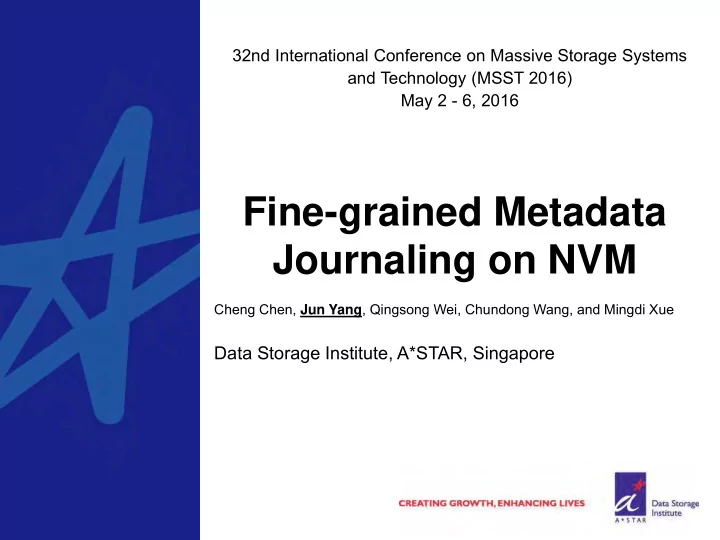

32nd International Conference on Massive Storage Systems and Technology (MSST 2016) May 2 - 6, 2016 Fine-grained Metadata Journaling on NVM Cheng Chen, Jun Yang , Qingsong Wei, Chundong Wang, and Mingdi Xue Data Storage Institute, A*STAR, Singapore
Introduction • Journaling file system – Write a “journal” to a circular log area before updating actual content – Can be metadata only or both metadata and data • Problems – Performance penalty – Inefficient journal writes due to block-based interface Pg 2
Overview • Enable journaling has performance penalty • Our observation – Around ~40% performance drop under common workloads – Journal write amplification due to block-based design • E.g. few inode changes cause the entire inode block to be written • Next generation of non-volatile memory (NVM) – DRAM-like byte-addressability and performance + persistency – But journaling on NVM still costs ~35% performance drop – How to improve? Eliminate journal write amplification • Our solution: Fine-grained metadata journaling – A new journal format to fully utilize the byte-addressable of NVM – Redesign the journaling process to reduce the writes – Reduce more than 90% unnecessary journal writes – Achieve up to 15x performance improvement under different workloads Pg 3
Background Conventional Journaling File System Pg 4
Background • NVM (Next Generation of Non-volatile Memory) – Provides DRAM-like performance and disk-like persistency CPU • Data consistency in NVM requires Cache line ordered memory writes Cache line Cache line Persistency boundary – Non-trivial due to CPU design Memory Bus • E.g, w1 , (MFENCE,CLFLUSH,MFENCE), w2 , (MFENCE,CLFLUSH,MFENCE) NVM Pg 5
Motivation Varmail Fileserver HDD ↓ 48.2% ↓ 40.9% Ramdisk ↓ 42.5% ↓ 33.6% Varmail Fileserver Pg 6
Design Decisions I. Use NVM as the journaling device II. Utilize the byte-addressability to eliminate the journal write amplification III. Further reduce the journal writes that requires ordered memory writes Pg 7
Our Solution Fine-grained Metadata Journaling • Move all the journal to NVM • Use inode as the basic unit for journaling Pg 8
Fine-grained Journal Format • Traditional approach – Block-based – Descriptor/Commit Block – Wasted space and writing time • TxnInfo – CPU-cache friendly – Configurable size – Consistent Pg 9
Optimized Workflow - Commit Pg 10
Optimized Workflow - Checkpoint Pg 11
Optimized Workflow - Recovery Pg 12
Experimental Setup • NVDIMM server – Intel Xeon E5-2650 • 2.4GHz, 512KB/2MB/20MB L1/L2/L3 Cache – 4GB DRAM, 4GB NVDIMM • NVDIMM has the same performance as DRAM – 300GB 15K-RPM HDD x 2 • Testing target – Baseline: Ext4 with JBD2 on Disk • “ordered” mode – Ext4 with JBD2 on NVM • Still block-based • Use memcpy with CLFLUSH and MFENCE – Our solution • Modified JBD2 with new log format and commit, checkpoint, recovery process • Write journal to NVM through memcpy with CLFLUSH and MFENCE Pg 13
Performance Result (1) Fileserver Workloads Performance Improvement Journal Write Reduction Conventional Conventional Block-based Journaling Journaling on HDD Journaling on NVM ↓ 90.4% ↑ 73.6% ↑ 41.6% Pg 14
Performance Result (2) 15x FileMicro_Writefsync Workloads Performance Improvement Journal Write Reduction Conventional Conventional Block-based Journaling Journaling on HDD Journaling on NVM ↓ 93.7% ↑ 15.8x ↑ 2.8x Pg 15
More in The Paper • Performance of other workloads – FileBench – Varmail – Postmark • Impact of the size of TxnInfo – Commit behavior – Overall throughput tuning Pg 16
Conclusion • We reveal the journal write amplification problem – Mainly due to the block interface – Journaling penalty is still high with high-performance NVM as journal device • We propose Fine-grained Metadata Journaling – Exploit the byte-addressability and high-performance of NVM – A new fine-grained journal format • CPU-cache friendly • Further reduce the amount of journal writes – Modified workflow of commit, checkpoint and recovery in journaling • Achieve up to 15x performance boost under different workloads Pg 17
Than Thank You k You! Q & A Q & A Jun Yang Email: yangju@dsi.a-star.edu.sg
Recommend
More recommend